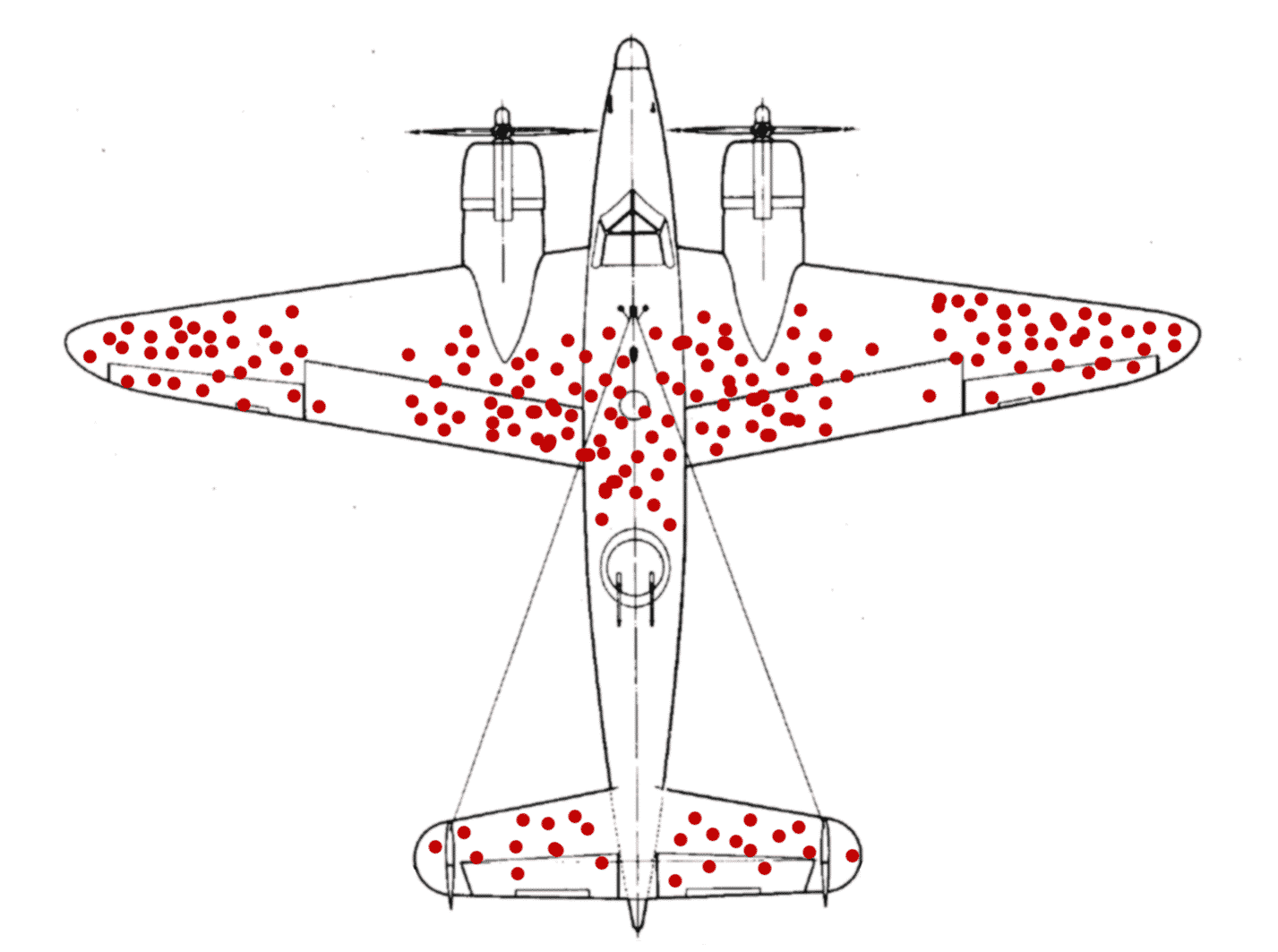Survivorship bias is a tricky fallacy to deal with.
We’re all mesmerised by success stories. But studying those who are successful isn’t always the best idea.
You might succumb to survivorship bias.
You might bet on flawed strategies.
Here we go:
Abraham Wald and the WWII Planes
During World War II, the Allies studied Nazi damage to their fighter planes. Their study resulted in this dotted illustration:

The analysis of these damages resulted in the idea that the Allied Forces should reinforce their fighter planes in the areas showing the densest clusters of red dots.
A statistician by the name of Abraham Wald disagreed. Instead, he suggested that they reinforce surfaces with no red dots. Wald was right, of course. The red-dotted areas indicated non-fatal damaged regions by studying planes that somehow returned home.
“Wald’s work on aircraft vulnerability, using data from survivors, was crucial in World War II, Korea, and Vietnam, and has been reissued by the Center for Naval Analyses.”
Source: Journal of the American Statistical Association 1Mangel, M., & Samaniego, F. (1984). Abraham Wald’s Work on Aircraft Survivability. Journal of the American Statistical Association, 79, 259 – 267. https://doi.org/10.1080/01621459.1984.10478038
If it had been possible to study all the planes shot down and destroyed by the Nazis, maybe the research team would have found an inverse pattern?
WWI and the Soldiers’ Helmets
In another example, we focus on a seemingly counterintuitive phenomenon that emerged during World War I.
As military forces began to issue more helmets to soldiers to protect them from the perils of the battlefield, an unexpected trend was observed: the number of wounded soldiers surged dramatically.
At first glance, it may seem that the helmets were paradoxically making it easier for more people to get hurt. The crux of this paradox lies in the shifting dynamics of the casualty statistics:
As helmets were introduced and distributed more widely, they significantly reduced the number of fatalities on the battlefield. Soldiers who would have previously succumbed to their injuries were now surviving. Consequently, these soldiers were classified as “wounded” rather than “dead.”
This shift in categorisation created the illusion of increased injuries when, in reality, the number of fatalities had decreased.
Survivorship Bias
Survivorship bias occurs when an individual focuses on successful examples or outcomes while ignoring those who failed or did not survive. This selective focus leads to a skewed understanding of reality, as it fails to account for the larger, often hidden, set of failures that could provide valuable insights.
Survivorship bias (example): “Most successful tech startups are based in Silicon Valley, so the best way to guarantee our success is to move our business there.”
In a business context, survivorship bias can distort decision-making by promoting overly optimistic or one-sided views of success. By only highlighting the survivors or success stories, organizations may overlook the challenges and risks that others faced and miss opportunities for learning from past failures.
To avoid the pitfalls of survivorship bias, business leaders must take a more comprehensive approach to evaluating success. This involves considering successes and failures, analyzing what led to both outcomes and applying those lessons to future strategies.
By embracing a balanced perspective that acknowledges triumphs and setbacks, organisations can make more informed, realistic decisions and avoid misguided assumptions based on incomplete data.
The loudest voices often belong to those who made it through, but the silence of those who didn’t is the true measure of what was left behind.
Read also: Survivorship Bias
Correlation is Not Causation
Survivorship bias underscores the importance of considering the larger context and being cautious about conclusions based solely on superficial data.
Both stories are excellent examples of a particular fallacy — survivorship bias.
“Survivorship bias, survival bias is the logical error of concentrating on entities that passed a selection process while overlooking those that did not. This can lead to incorrect conclusions because of incomplete data.”
Source: Wikipedia 2Survivorship bias. (2023, October 9). In Wikipedia. https://en.wikipedia.org/wiki/Survivorship_bias
We often can’t help being enticed by success stories in popular culture and business. But their stories can lead us to fallacious conclusions.
Few think about studying those who turn out to be unsuccessful. This is too bad for data sets since the unsuccessful typically outnumber the successful by a vast margin.
Survivorship bias (mental model). This cognitive bias involves focusing on people or things that have “survived” some process and inadvertently overlooking those that did not due to their lack of visibility. This can lead to false conclusions because it ignores the experiences of those who did not make it through the process. 3Silfwer, J. (2019, October 17). Survivorship Bias. Doctor Spin | The PR Blog. https://doctorspin.net/survivorship-bias/
False Causality
False causality: “Our sales increased dramatically after we launched the new logo. Therefore, the new logo must be the reason for the sales boost.”
The false causality fallacy, also known as correlation, does not imply causation and occurs when an individual assumes that just because two events occurred together, one must have caused the other. This fallacy ignores the possibility that other factors might be at play or that the correlation could be coincidental.
In business, false causality can lead to misguided strategies and decisions, as organizations may attribute success or failure to the wrong factors. By oversimplifying cause-and-effect relationships, companies risk implementing ineffective strategies or overlooking the proper drivers behind their outcomes.
To avoid the pitfalls of false causality, business leaders must critically examine the relationship between events and seek to understand the full range of factors that could be influencing outcomes. Thorough analysis, using data and evidence, is essential to identify real causes and separate them from coincidental correlations. This promotes smarter decision-making and ensures strategies are based on sound reasoning and a deep understanding of the business environment.
Learn more: Logical Fallacies and Cognitive Biases

THANKS FOR READING.
Need PR help? Hire me here.

What should you study next?
Spin Academy | Online PR Courses

Spin’s PR School: Free Psychology PR Course
Join this free Psychology PR Course to learn essential skills tailored for public relations professionals. Start now and amplify your impact on society today.
Psychology in Public Relations
Group Psychology
Learn more: All Free PR Courses
💡 Subscribe and get a free ebook on how to get better PR.

Annotations
| 1 | Mangel, M., & Samaniego, F. (1984). Abraham Wald’s Work on Aircraft Survivability. Journal of the American Statistical Association, 79, 259 – 267. https://doi.org/10.1080/01621459.1984.10478038 |
|---|---|
| 2 | Survivorship bias. (2023, October 9). In Wikipedia. https://en.wikipedia.org/wiki/Survivorship_bias |
| 3 | Silfwer, J. (2019, October 17). Survivorship Bias. Doctor Spin | The PR Blog. https://doctorspin.net/survivorship-bias/ |


